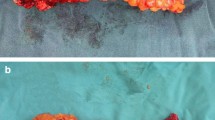Abstract
This study was performed to retrospectively analyze and compare the related clinical indicators between extralevator abdominoperineal excision (ELAPE) and non-ELAPE under laparoscopic for low rectal cancer. From June 2018 to September 2021, a total of 80 patients with low rectal cancer who underwent either of the above two types of surgeries at our Hospital were enrolled. Patients were divided into the ELAPE group and non-ELAPE group based on the different surgical methods. Preoperative general indicators, intraoperative indicators, postoperative complications, positive circumferential resection margin rate, local recurrence rate, hospital stay length, hospital expenses, and other related indicators were compared between the two groups. There were no significant differences in the comparison of preoperative indexes between the ELAPE group and non-ELAPE group, including age, preoperative BMI, and gender. Similarly, there were no significant differences in abdominal operation time, total operation time, and the number of intraoperative lymph nodes dissected between the two groups. However, the perineal operation time, intraoperative blood loss, intraoperative perforation rate, and positive circumferential resection margin rate were significantly different between the two groups. In the comparison of postoperative indexes, perineal complications, postoperative hospital stay length, and IPSS score were significantly different between the two groups. The use of ELAPE in treating T3-4NxM0 phase low rectal cancer was superior to non-ELAPE in reducing intraoperative perforation rate, positive circumferential resection margin rate, local recurrence rate, etc.
Similar content being viewed by others
Data availability
The datasets used and/or analyzed during the current study available from the corresponding author on reasonable request.
References
Wei MM, Wang SS, Zheng JL, Chen L, Peng X, Chen JF et al (2022) Herbal medicine teng-long-bu-zhong-tang inhibitsthe growth of human RKO colorectal cancer by regulating apoptosis, senescence, and angiogenesis. World J Tradit Chin Med 8:110–114
Zheng RS, Zhang SW, Zeng HM et al (2022) Cancer incidence and mor-tality in China, 2016. J Natl Cancer Cent 2(1):1–9
Yu PM (2011) Re-conceptualization of the clinical significance of the classification of rectal cancer as high, intermediate, low and ultra-low. Chin J Gastrointes Surg 10:821–822. https://doi.org/10.3760/cma.j.issn.1671-0274.2011.10.31
Bianco F, Romano G, Tsarkov P et al (2017) Extralevator with vs nonextralevator abdominoperineal excision for rectal cancer: the RELAPe randomized controlled trial. Colorectal Dis 19(2):148–157. https://doi.org/10.1111/codi.13436
Du XH, Yan Y (2020) Take the rational view on the application of robotic surgery in gastrointestinal field in China. Zhonghua Wei Chang Wai Ke Za Zhi. 23(4):341–344. https://doi.org/10.3760/cma.j.cn.441530-20200212-00051. (Chinese)
Zheng MH, Feng B, Ma JJ et al (2018) Guidelines for laparoscopic radical resection of colorectal cancer (2018 edition). Chin J Dig Surg 17(09):877–885
Holm AN, Baron TH (2007) Palliative use of percutaneous endoscopic gastrostomy and percutaneous endoscopic cecostomy tubes. Gastrointest Endosc Clin N Am 17(4):795–803. https://doi.org/10.1016/j.giec.2007.07.002. (PMID: 17967383)
Sung H, Ferlay J, Siegel RL et al (2021) Global cancer statistics 2020: GLOBOCAN estimates of incidence and mortality worldwide for 36 cancers in 185 countries. CA Cancer J Clin 71(3):209–249
Barker T, Branagan G, Wright E et al (2013) Vertical rectus abdominis myocutaneous flap reconstruction of the perineal defect after abdominoperineal excision is associated with low morbidity. Colorectal Dis 15(9):1177–1183. https://doi.org/10.1111/codi.12286
AUA guideline on management of benign prostatic hyperplasia (2003) Chapter 1: Diagnosis and treatment recommendations. J Urol 170(2 Pt 1):530–547
Fleming CA, Cullinane C, Lynch N, Killeen S, Coffey JC, Peirce CB (2021) Urogenital function following robotic and laparoscopic rectal cancer surgery: meta-analysis. Br J Surg 108(2):128–137. https://doi.org/10.1093/bjs/znaa067. (PMID: 33711141)
Keane C, Fearnhead NS, Bordeianou LG, Christensen P, Basany EE, Laurberg S, Mellgren A, Messick C, Orangio GR, Verjee A, Wing K, Bissett I, LARS International Collaborative Group (2020) International consensus definition of low anterior resection syndrome. Dis Colon Rectum 63(3):274–284
Chapman SJ, Bolton WS, Corrigan N, Young N, Jayne DG (2017) A cross-sectional review of reporting variation in postoperative bowel dysfunction after rectal cancer surgery. Dis Colon Rectum 60(2):240–247
Lim RS, Yang TX, Chua TC (2014) Postoperative bladder and sexual function in patients undergoing surgery for rectal cancer: a systematic review and meta-analysis of laparoscopic versus open resection of rectal cancer. Tech Coloproctol 18(11):993–1002
Prytz M, Angenete E, Bock D et al (2016) Extralevator abdominoperineal excision for low rectal cancer-extensive surgery to be used with discretion based on 3-year local recurrence results: a registry-based observational national cohort study. Ann Surg 263(3):516–521
Stelzner S, Holm T, Moran BJ et al (2011) Deep pelvic anatomy revisited for a description of crucial steps in extralevator abdominoperineal excision for rectal cancer. Dis Colon Rectum 54(8):947–957
Heald RJ, Husband EM, Ryall RD (1982) The mesorectum in rectal cancer surgery–the clue to pelvic recurrence? Br J Surg 69(10):613–616
Wang ZJ, Han JG (2014) Pelvic floor repair after combined extra-abdominal perineal rectal resection for low rectal cancer. Chin J Gastrointes Surg 17(06):540–543. https://doi.org/10.3760/cma.j.issn.1671-0274.2014.06.005
Marshall MJ, Smart NJ, Daniels IR (2012) Biologic meshes in perineal reconstruction following extra-levator abdominoperineal excision (elAPE). Colorectal Dis 14(Suppl 3):12–18. https://doi.org/10.1111/codi.12044
Zhang X, Wang Z, Liang J et al (2015) Transabdominal extralevator abdominoperineal excision (eLAPE) performed by laparoscopic approach with no position change. J Laparoendosc Adv Surg Tech A 25(3):202–206
Funding
No external funding received to conduct this study.
Author information
Authors and Affiliations
Corresponding author
Ethics declarations
Conflict of interest
The authors declare that they have no competing interests.
Additional information
Publisher's Note
Springer Nature remains neutral with regard to jurisdictional claims in published maps and institutional affiliations.
Rights and permissions
Springer Nature or its licensor (e.g. a society or other partner) holds exclusive rights to this article under a publishing agreement with the author(s) or other rightsholder(s); author self-archiving of the accepted manuscript version of this article is solely governed by the terms of such publishing agreement and applicable law.
About this article
Cite this article
He, Z., Yang, X.y., Yang, Xg. et al. Comparison of the clinical efficacy of laparoscopic extralevator abdominoperineal excision (ELAPE) and non-ELAPE for low rectal cancer. Updates Surg 75, 611–617 (2023). https://doi.org/10.1007/s13304-023-01466-y
Received:
Accepted:
Published:
Issue Date:
DOI: https://doi.org/10.1007/s13304-023-01466-y




